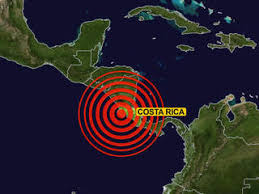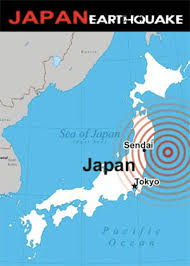Don’t panic! Preliminary data suggest earthquakes are indeed increasing worldwide



December 31, 2012 – EARTHCHANGES – In recent weeks, worldwide earthquake data indicates an increase in the magnitude and a significant increase in the frequency (magnitude 5.5+) of earthquakes. Current graphs clearly show an alarming worldwide trend of increasing earthquake strength and frequency. These results are in agreement with the USGS statistics page, which shows an increase in the frequency of stronger earthquakes (M 5.0+). These trends also show that the depth of earthquakes has diminished, they occur closer to the Earth’s surface. Shallow earthquakes occur along fault lines and are due to the accumulation of stress. Earthquake waves can also propagate far enough to trigger other earthquakes; this may explain the noted increase in earthquakes. Certain scientists have stated that the increased frequency of earthquakes is due to the increased number of detection instruments installed worldwide. This would cause more sensitive earthquakes to be measured. However, these graphs show an increase in stronger earthquakes; it is also important to note that the earthquake Richter scale is base-10 logarithmic. The fact that the world’s population has increased doesn’t help, more people are affected by these events. There is increased media availability and attention. However, due to recent events, it is now easy to convince even the average person, that there are more and more strong earthquakes occurring worldwide. –Guardianlv (excerpt)
 Largest increase in 62 years: According to the Costa Rican Volcanology and Seismology Observatory (OVSICORI), after the magnitude 7.6 earthquake which occurred on September 5th, 2012, the country registered the highest level of earthquake activity it has seen in 62 years. The strongest earthquakes in Costa Rican history occurred in 1950 in Nicoya, with a 7.8 magnitude quake, followed by the 2012 earthquake that occurred in the same area, of a 7.6 magnitude. After the September 5th earthquake, OVSICORI reported 75 earthquakes that were felt by residents during the 4 months after the main event. 2010 saw a total of 6,245 earthquakes, in 2011 there were 5,483, and in 2012 the total was 11,049. –Inside Costa Rica
Largest increase in 62 years: According to the Costa Rican Volcanology and Seismology Observatory (OVSICORI), after the magnitude 7.6 earthquake which occurred on September 5th, 2012, the country registered the highest level of earthquake activity it has seen in 62 years. The strongest earthquakes in Costa Rican history occurred in 1950 in Nicoya, with a 7.8 magnitude quake, followed by the 2012 earthquake that occurred in the same area, of a 7.6 magnitude. After the September 5th earthquake, OVSICORI reported 75 earthquakes that were felt by residents during the 4 months after the main event. 2010 saw a total of 6,245 earthquakes, in 2011 there were 5,483, and in 2012 the total was 11,049. –Inside Costa Rica
 Japan shaking more: Japan had experienced a little over 3,000 noticeable earthquakes in 2012, nearly 60 percent of them aftershocks from last year’s massive tremor that devastated the country’s northeast, Japanese media reported on Monday. Quoting the Japan Meteorological Agency, the NHK broadcaster reported that a total of 3,134 quakes had been felt across Japan until Sunday (December 30) which is about 1,000 more than the annual average from 2001 to 2010. An analysis of seismic waves indicates that there were more than 10,000 noticeable quakes in 2011. While the number of quakes decreased from that of last year, seismologists continue to monitor frequent seismic activity. They urged people to be on the alert for possible strong quakes with a magnitude of at least 7 or those triggering tsunami. The March 11, 2011 quake and the tsunami it triggered had left more than 15,000 people dead or missing besides wreaking havoc in Japan’s northeast, including the meltdown at the Fukushima Daiichi nuclear power plant that leaked radiation forcing the evacuation of more than 160,000 residents. –RTT
Japan shaking more: Japan had experienced a little over 3,000 noticeable earthquakes in 2012, nearly 60 percent of them aftershocks from last year’s massive tremor that devastated the country’s northeast, Japanese media reported on Monday. Quoting the Japan Meteorological Agency, the NHK broadcaster reported that a total of 3,134 quakes had been felt across Japan until Sunday (December 30) which is about 1,000 more than the annual average from 2001 to 2010. An analysis of seismic waves indicates that there were more than 10,000 noticeable quakes in 2011. While the number of quakes decreased from that of last year, seismologists continue to monitor frequent seismic activity. They urged people to be on the alert for possible strong quakes with a magnitude of at least 7 or those triggering tsunami. The March 11, 2011 quake and the tsunami it triggered had left more than 15,000 people dead or missing besides wreaking havoc in Japan’s northeast, including the meltdown at the Fukushima Daiichi nuclear power plant that leaked radiation forcing the evacuation of more than 160,000 residents. –RTT
 Over 5,000 quakes shake Mexico: In 2012, 5,043 earthquakes, including more than 1,484 with their epicenter in Chiapas, shook Mexico, according to the State Civil Protection System, local media reported. That number is likely to increase before the year’s end. In fact, two four-magnitude earthquakes in the Richter scale were reported some 67 kilometers southwest of Ciudad Hidalgo on Friday, but there was no visible damage. The State Civil Protection System noted that seismic activity is caused by the convergence of three tectonic plates in North America, Cocos and the Caribbean. Coincidently, at the onset of 2013, a 4.5 magnitude earthquake struck off the coast of Oaxaca Mexico. –Prensa Latina
Over 5,000 quakes shake Mexico: In 2012, 5,043 earthquakes, including more than 1,484 with their epicenter in Chiapas, shook Mexico, according to the State Civil Protection System, local media reported. That number is likely to increase before the year’s end. In fact, two four-magnitude earthquakes in the Richter scale were reported some 67 kilometers southwest of Ciudad Hidalgo on Friday, but there was no visible damage. The State Civil Protection System noted that seismic activity is caused by the convergence of three tectonic plates in North America, Cocos and the Caribbean. Coincidently, at the onset of 2013, a 4.5 magnitude earthquake struck off the coast of Oaxaca Mexico. –Prensa Latina
 Koreas report increase in quakes: A study has found that, including North Korea and the seas, our country experienced twice as many earthquakes this year as in the past. According to the Korea Meterological Association on the 27th, there were 56 earthquakes on the Korean Peninsula this year through last month, twice the average since record-keeping began in 1978. The highest number, 60, was recorded in 2009. It’s also over ten more than the average of 43.6 recorded each year since digital detection methods were begun in 1999. There were nine which reached at least 3.0 on the Richter scale and four which were strong enough to be felt by people. Other than in the seas the largest number, 11, were in the Daegu and Gyeongsangbuk-do area, followed by four in Jeollabuk-do and two each in Busan, Ulsan, and Gyeongsangnam-do. In North Korea seven earthquakes were recorded, and there were none in the capital region of Seoul, Gyeonggi-do, and Incheon. There were 12 in the West Sea, nine in the Sea of Japan (East Sea), and seven in the South Sea. The strongest earthquake of the year so far occurred on May 11th at 12:46 pm, five kilometers east-northeast of Muju-gun in Jeollabuk-do, registering a 3.9 on the Richter scale. Houses and windows shook in Muju and Namwon, at an intensity level of IV. In Daegu and Daejeon the intensity was of level II but there was no damage. The increased number of earthquakes in recent years is likely due to the effects of the Great East Japan Earthquake of 2010, the KMA said. In this country there were 42 earthquakes in 2010, 52 last year, and 56 as of Christmas of this year. Kim Yeong-shin of the KMA said that “around the world in recent years there has been an increasing number of earthquakes… since the Great East Japan Earthquake there has been a slight decrease as energy levels seem to have been adjusted.” –Asian Correspondent
Koreas report increase in quakes: A study has found that, including North Korea and the seas, our country experienced twice as many earthquakes this year as in the past. According to the Korea Meterological Association on the 27th, there were 56 earthquakes on the Korean Peninsula this year through last month, twice the average since record-keeping began in 1978. The highest number, 60, was recorded in 2009. It’s also over ten more than the average of 43.6 recorded each year since digital detection methods were begun in 1999. There were nine which reached at least 3.0 on the Richter scale and four which were strong enough to be felt by people. Other than in the seas the largest number, 11, were in the Daegu and Gyeongsangbuk-do area, followed by four in Jeollabuk-do and two each in Busan, Ulsan, and Gyeongsangnam-do. In North Korea seven earthquakes were recorded, and there were none in the capital region of Seoul, Gyeonggi-do, and Incheon. There were 12 in the West Sea, nine in the Sea of Japan (East Sea), and seven in the South Sea. The strongest earthquake of the year so far occurred on May 11th at 12:46 pm, five kilometers east-northeast of Muju-gun in Jeollabuk-do, registering a 3.9 on the Richter scale. Houses and windows shook in Muju and Namwon, at an intensity level of IV. In Daegu and Daejeon the intensity was of level II but there was no damage. The increased number of earthquakes in recent years is likely due to the effects of the Great East Japan Earthquake of 2010, the KMA said. In this country there were 42 earthquakes in 2010, 52 last year, and 56 as of Christmas of this year. Kim Yeong-shin of the KMA said that “around the world in recent years there has been an increasing number of earthquakes… since the Great East Japan Earthquake there has been a slight decrease as energy levels seem to have been adjusted.” –Asian Correspondent
 Fivefold increase in Peru: Peru has been shocked by a total of 225 sensitive earthquakes, during 2012, Geophysical Institute of Peru (IGP) reported Monday. Hernando Tavera, head of IGP’s Seismology said in statements to Andina news agency that the highest percentage of earthquakes, probably 70 percent, was centered off the coast of Peru. He noted that mostly the cities of Arequipa, Ica and Lima, in Peru’s central region and southern Peruvian coast, were the most affected by the several earthquakes. Tavera added that recent earthquakes occurring off the coast, from Tumbes to Tacna, which is the area of highest risk to be affected by a major earthquake and where the subsurface tectonic plates are constantly moving. “It happens that offshore is exactly where the Nazca plate colliding head-on with the South American plate, and there is the problem,” he told Andina news agency. The IGP only reports the tremors sensitive to the population, but the not sensitive are usually two to three daily. According to Lima Easy, only 45 seismic events were listed for all of 2011. –Andina, Limaeasy
Fivefold increase in Peru: Peru has been shocked by a total of 225 sensitive earthquakes, during 2012, Geophysical Institute of Peru (IGP) reported Monday. Hernando Tavera, head of IGP’s Seismology said in statements to Andina news agency that the highest percentage of earthquakes, probably 70 percent, was centered off the coast of Peru. He noted that mostly the cities of Arequipa, Ica and Lima, in Peru’s central region and southern Peruvian coast, were the most affected by the several earthquakes. Tavera added that recent earthquakes occurring off the coast, from Tumbes to Tacna, which is the area of highest risk to be affected by a major earthquake and where the subsurface tectonic plates are constantly moving. “It happens that offshore is exactly where the Nazca plate colliding head-on with the South American plate, and there is the problem,” he told Andina news agency. The IGP only reports the tremors sensitive to the population, but the not sensitive are usually two to three daily. According to Lima Easy, only 45 seismic events were listed for all of 2011. –Andina, Limaeasy

 Over 5,000 quakes shake Mexico: In 2012, 5,043 earthquakes, including more than 1,484 with their epicenter in Chiapas, shook Mexico, according to the State Civil Protection System, local media reported. That number is likely to increase before the year’s end. In fact, two four-magnitude earthquakes in the Richter scale were reported some 67 kilometers southwest of Ciudad Hidalgo on Friday, but there was no visible damage. The State Civil Protection System noted that seismic activity is caused by the convergence of three tectonic plates in North America, Cocos and the Caribbean. Coincidently, at the onset of 2013, a 4.5 magnitude earthquake struck off the coast of Oaxaca Mexico. –Prensa Latina
Over 5,000 quakes shake Mexico: In 2012, 5,043 earthquakes, including more than 1,484 with their epicenter in Chiapas, shook Mexico, according to the State Civil Protection System, local media reported. That number is likely to increase before the year’s end. In fact, two four-magnitude earthquakes in the Richter scale were reported some 67 kilometers southwest of Ciudad Hidalgo on Friday, but there was no visible damage. The State Civil Protection System noted that seismic activity is caused by the convergence of three tectonic plates in North America, Cocos and the Caribbean. Coincidently, at the onset of 2013, a 4.5 magnitude earthquake struck off the coast of Oaxaca Mexico. –Prensa Latina  Koreas report increase in quakes: A study has found that, including North Korea and the seas, our country experienced twice as many earthquakes this year as in the past. According to the Korea Meterological Association on the 27th, there were 56 earthquakes on the Korean Peninsula this year through last month, twice the average since record-keeping began in 1978. The highest number, 60, was recorded in 2009. It’s also over ten more than the average of 43.6 recorded each year since digital detection methods were begun in 1999. There were nine which reached at least 3.0 on the Richter scale and four which were strong enough to be felt by people. Other than in the seas the largest number, 11, were in the Daegu and Gyeongsangbuk-do area, followed by four in Jeollabuk-do and two each in Busan, Ulsan, and Gyeongsangnam-do. In North Korea seven earthquakes were recorded, and there were none in the capital region of Seoul, Gyeonggi-do, and Incheon. There were 12 in the West Sea, nine in the Sea of Japan (East Sea), and seven in the South Sea. The strongest earthquake of the year so far occurred on May 11th at 12:46 pm, five kilometers east-northeast of Muju-gun in Jeollabuk-do, registering a 3.9 on the Richter scale. Houses and windows shook in Muju and Namwon, at an intensity level of IV. In Daegu and Daejeon the intensity was of level II but there was no damage. The increased number of earthquakes in recent years is likely due to the effects of the Great East Japan Earthquake of 2010, the KMA said. In this country there were 42 earthquakes in 2010, 52 last year, and 56 as of Christmas of this year. Kim Yeong-shin of the KMA said that “around the world in recent years there has been an increasing number of earthquakes… since the Great East Japan Earthquake there has been a slight decrease as energy levels seem to have been adjusted.” –Asian Correspondent
Koreas report increase in quakes: A study has found that, including North Korea and the seas, our country experienced twice as many earthquakes this year as in the past. According to the Korea Meterological Association on the 27th, there were 56 earthquakes on the Korean Peninsula this year through last month, twice the average since record-keeping began in 1978. The highest number, 60, was recorded in 2009. It’s also over ten more than the average of 43.6 recorded each year since digital detection methods were begun in 1999. There were nine which reached at least 3.0 on the Richter scale and four which were strong enough to be felt by people. Other than in the seas the largest number, 11, were in the Daegu and Gyeongsangbuk-do area, followed by four in Jeollabuk-do and two each in Busan, Ulsan, and Gyeongsangnam-do. In North Korea seven earthquakes were recorded, and there were none in the capital region of Seoul, Gyeonggi-do, and Incheon. There were 12 in the West Sea, nine in the Sea of Japan (East Sea), and seven in the South Sea. The strongest earthquake of the year so far occurred on May 11th at 12:46 pm, five kilometers east-northeast of Muju-gun in Jeollabuk-do, registering a 3.9 on the Richter scale. Houses and windows shook in Muju and Namwon, at an intensity level of IV. In Daegu and Daejeon the intensity was of level II but there was no damage. The increased number of earthquakes in recent years is likely due to the effects of the Great East Japan Earthquake of 2010, the KMA said. In this country there were 42 earthquakes in 2010, 52 last year, and 56 as of Christmas of this year. Kim Yeong-shin of the KMA said that “around the world in recent years there has been an increasing number of earthquakes… since the Great East Japan Earthquake there has been a slight decrease as energy levels seem to have been adjusted.” –Asian Correspondent